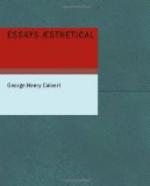To accompany Dante through his vast triple trans-terrestrial world, would seem to demand in the reader a sustained effort of imagination. But Dante is so graphic, and, we might add, corporeal in his pictures, puts such a pulse into his figures, that the artistic illusion wherewith we set out is exchanged for, or rather overborne by, an illusion of the reality of what is represented. Yet from the opening of the first canto he is ever in the super-earthly world, and every line of the fourteen thousand has the benefit of a super-earthly, that is, a poetic atmosphere, which lightens it, transfigures it, floats it. One reads with the poetic prestige of the knowledge that every scene is trans-terrestrial; and, at the same time, every scene is presented with a physical realism, a visual and audible vividness, which captivates and holds the perceptive faculty; so that the reader finds himself grasped, as it were, in a vice, whose double handle is mortised on one side in the senses, and on the other in the spiritual imagination.
Dante had it in him,—this hell, purgatory, and heaven—so full and warm and large was his nature. Within his own breast he had felt, with the keen intensity of the poetic temperament, the loves and hates, the griefs and delights of life. Through his wealth of heart he had a fellow-feeling for all the joys and sorrows of his brother-men, and, added to this, an artist’s will and want to reproduce them, and to reproduce them a clear, outwelling, intellectual vivacity. He need scarcely have told us that his poem, though treating of spirits, relates to the passions and doings of men in the flesh. He chose a theme that at once seized the attention of his readers, and gave to himself a boundless scope. His field was all past history, around the altitudes of which are clustered biographical traits and sketches of famous sinners and famous saints, of heroes and lofty criminals; and, along with this, contemporaneous Florentine and Italian history, with its tumults and vicissitudes, its biographies and personalities, its wraths and triumphs.
Dante exhibits great fertility in situations and conjunctions; but, besides that many of them were ready to his hand, this kind of inventiveness denotes of itself no fine creative faculty. It is the necessary equipment of the voluminous novelist. In this facility and abundance Goldsmith could not have coped with James and Bulwer; and yet the “Vicar of Wakefield” (not to go so high as “Tristram Shandy” and “Don Quixote”) is worth all their hundred




